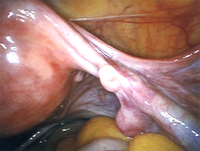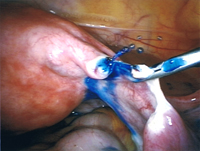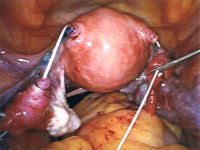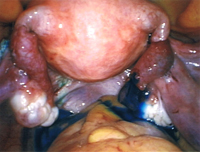Laparoscopic Tubal Ligation Reversal, a minimally-invasive surgery, uses small, specially-designed instruments to repair and reconnect the fallopian tubes.
Our Tubal Ligation Reversal Technique
After general anesthesia has been administered, we begin by inserting a 10mm (about 3/8-inch) tube just at the lower edge of the navel, and a special gas is pumped into the abdomen to create enough space to perform the operation safely and precisely.
The laparoscope (a telescope), attached to a camera, is brought into the abdomen through the same tube and the pelvis and abdomen are thoroughly inspected. The tubes are evaluated and the obstruction (ligation, burn, ring, or clip) is examined.

Three small instruments (5mm each) are used to remove the occlusion and prepare the two segments of the tube to be reconnected.
A special instrument (tubal cannulator) is inserted into the uterus (womb) through the cervix, and the tube is threaded with a fine stent. This allows for improved alignment of the tubes, so a much better connection can be accomplished.
Tiny sutures (less than a hair in thickness) are carefully and meticulously placed to connect the two segments.

Once the connection (anastomosis) is completed, a blue dye is injected through the cervix, traveling through the uterus and tubes, all the way to the abdomen. This is to make sure the tubes have been aligned properly and that the connection is working well.
All instruments are removed, the air is extracted from the abdomen, and the patient is awakened and taken to the recovery room to be watched and cared for by the nurses, as well as by the anesthesiologist who makes sure the patient is comfortable and without pain.
On average, most laparoscopic tubal ligation reversal patients are ready to be discharged two to four hours later. 
Patients are seen between 5-7 days after the tubal ligation reversal to look at the small incisions and remove any stitches if necessary. Most of the time, the few stitches that were placed will be under the skin and will be absorbed by the body, without need for removal.
 All laparoscopic tubal ligation reversal procedures are performed by certified laparoscopic surgeons with 30 years of experience in laparoscopic surgery, using state-of-the-art equipment and instruments.
All laparoscopic tubal ligation reversal procedures are performed by certified laparoscopic surgeons with 30 years of experience in laparoscopic surgery, using state-of-the-art equipment and instruments.
Our center has a unique advantage in helping you. Most fertility centers specialize in either the surgical repair of the tubes or in IVF. We can offer both, so we can objectively assess the treatment option most suitable for you, and offer you the best solution.
IVF may be better for patients who have been diagnosed with certain types of infertility or who do not have sufficient tubal tissue for reversal, as well as when the husband/partner has very low sperm count. For this reason, we perform a careful evaluation of each patient prior to recommending a course of treatment.
Please note that the technical success of the Tubal Ligation Reversal procedure depends on the surgeon’s expertise and the type of tubal ligation. Future pregnancies depend on other important factors such as sperm quality, hormonal status, and age. We recommend to first assess these other fertility factors to ascertain that a Tubal Ligation reversal is indeed the best solution rather than performing the procedure and realizing later that because of a very low sperm count, for example, an IVF is needed for achieving a pregnancy. Midwest Fertility Center is so confident in its Laparoscopic Tubal Reversal Success Rate that we will provide free IVF if the procedure is not successful (provided that the patient is an ideal candidate).